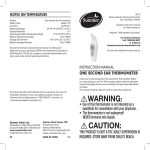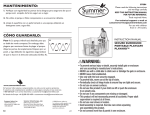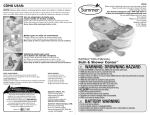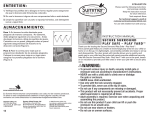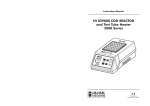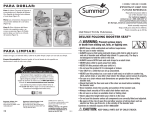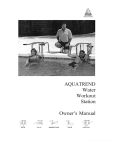Download Instruction Manual Heart-To-Heart® Digital Prenatal Listening System
Transcript
06110 RADIO AND TELEVISION INTERFERENCE This equipment has been tested and found to comply with the limits for a Class B digital device, pursuant to Part 15 of the FCC rules. These limits are designed to provide reasonable protection against harmful interference in a residental installation. This equipment generates, uses and can radiate radio frequency energy and, if not installed and used in accordance with the instructions, may cause harmful interference to radio communications. However, there is no guarantee that interference will not occur in a particular installation. If this equipment does cause harmful interference to radio or television reception, which can be determined by turning the equipment off and on, the user is encouraged to try to correct the interference by one of more of the following measures: • Reorient or relcoate the receiving antenna. • Increase the separation between the equipment and the receiver. • Connect the equipment into an outlet on a circuit different from that to which the receiver is connected. • Consult the dealer or an experienced radio/TV technician for help. You may also find helpful the following booklet, prepared by the FCC: “How to Identify and Resolve Radio-TV Interference Problems”. This booklet is available from the US Government Printing Office, Washington D.C. 20402. Changes and modification not expressly approved by Summer Infant , Inc. can void your authority to operate this equipment under Fderal Communications Commissions rules. This device complies with part 15 of FCC Rules. Operation is subject to the following two conditions; (1) This device may not cause harmful interference, and (2) this device must accept any interference received, including interference that may cause undesired operation. This Class B digital apparatus complies with Canadian ICES-003. C’et appareil numérique de la classe B est conforme à la norme NMB-003 du Canada. visit us at www.summerinfant.com We at Summer Infant stand behind all of our products. If you are not completely satisfied or have any questions, please contact our Customer Service Department at 1-800-268-6237 or e-mail us at [email protected]. In Europe, call +44 (0) 208 420 4429, or e-mail us at [email protected] Summer Infant, Inc. 1275 Park East Drive Woonsocket, RI 02895 USA 1-800-268-6237 Summer Infant Europe, Ltd. Office Suite 6, Second Floor Bournehall House, Bournehall Road Bushey, Hertfordshire WD23 3HP +44 (0) 208 420 4429 © 2009 Summer Infant, Inc. Please retain information for future reference. Colors and styles may vary. MADE IN CHINA. 10/09 For technical support, e-mail at [email protected] Instruction Manual Heart-To-Heart® Digital Prenatal Listening System The Heart to Heart® Digital Prenatal Listening System is easy to use. You will get the best results by reading the instructions before use. The Heart to Heart® Digital Prenatal Listening System is a wonderful way to hear and share the precious sounds of your baby’s hearbeat and movements. It is a completely safe and non-invasive way to listen to your unborn baby. Unlike ultrasound, it emits no energy into you or your baby. NOTE: The Heart to Heart® Digital Prenatal Listening System is NOT a medical device. It should NOT be used or relied upon for diagnostic or other medical purposes. This product should not be used in place of regular prenatal care by your physician. The Heart to Heart® Digital Prenatal Listening System can begin to detect your baby’s heartbeats at the beginning of your third trimester - typically around 28 weeks. See page 6 for factors influencing the ability to hear your baby’s heartbeat. WARNING: Earbuds pose a strangulation danger to young children. When not in use, store entire system out of reach of children. Features & Components: Sensor Unit power/ volume dial headphone jack headphone jack sound light indicator (flashing blue) Listening: Earbuds (2 Sets) belt clip belt clip Positioning Belt battery door low battery indicator (light will illuminate amber when battery is low) Set Up & Use: Installing the Battery: Step 1: Remove the battery door on sensor unit by sliding it off (Figure A). Step 2: Attach a 9 volt battery (not included) to battery connector ensuring correct battery polarity (Figure B). Place battery into compartment and slide battery door back onto sensor unit. Listening with earbuds Hearing your baby’s heartbeats and other sounds is a precious, exciting experience.You can listen to those sounds with the earbuds provided with the Heart-to-Heart® Digital Prenatal Listening System. Simply plug earbuds into the headphone jack. Use only the earbuds provided to listen to your baby’s sounds. NOTE: You can use almost any stereo earbuds with the Heart-to-Heart® Digital Prenatal Listening System; however, some earbuds may not adequately reproduce the sounds. Care & Maintenance: To clean the sensor unit and earbuds, simply wipe them with a damp cloth. To wash the belt, remove it from the sensor unit and fasten the hook and loop closure. Wash with similar colors in the gentle cycle of your washing machine/ tumble dry using the delicate cycle of your dryer. The Heart to Heart® Digital Prenatal Listening System is carefully designed to ensure optimum sensitivity. Like other sophisticated electronic equipment, The Heart to Heart® Digital Prenatal Listening System can be damaged if not handled with care. In addition, the earbuds and belt may pose a danger to young children. Therefore, please follow these safety precautions: • Always disconnect earbuds when not in use. • Keep your Heart to Heart® Digital Prenatal Listening System out of water. • When not in use store your Heart to Heart® Digital Prenatal Listening System out of reach of children. • Do not drop your Heart to Heart® Digital Prenatal Listening System. Using your Heart-to-Heart® Digital Prenatal Listening System NOTE: The best time to listen is 3-4 hours after eating and when you are relaxed. • If you will be storing your system for an extended period of time, be sure to remove your battery. Battery corrosion that may occur will damage the unit. • Dispose of exhausted battery properly. Step 1: Insert pointed end of positioning belt through either belt clip on side of unit and pull all of the way through. Make sure knotted end is facing out as shown (Figure C). knotted end 7 Factors Influencing The Ability To Hear Your Baby’s Heartbeat Please be patient when using this product. Do not be alarmed if you are not able to hear your baby’s heartbeat and movements right away. The more you use the Heart-to-Heart® Digital Prenatal Listening System, the easier it will be to find your baby’s heartbeat. The optimal time to listen to your baby’s heartbeat is a couple of hours after eating. Best results are found when Mom is completely relaxed in a quiet room. The following factors can also affect when and how well you will hear your baby’s heart beating. Set Up & Use (continued): Step 2: Wrap the belt around your torso, insert pointed end of positioning belt into belt clip on other side of unit, adjusting the belt to fit snugly yet comfortably.The sensor unit should fall just below your navel. Use the hook and loop tab to secure the belt. NOTE: The purpose of the belt is to hold the sensor in place and snug against your skin.You can use other methods to hold it in place.You may find it more comfortable to position the sensor underneath the snug-fitting mesh of maternity pants. Stage of your Pregnancy The Heart-to-Heart® Digital Prenatal Listening System will usually begin to detect baby’s sounds at the beginning of your third trimester - typically around 28 weeks. At this stage of your pregnancy, adjust the position of the Heart-to-Heart® Digital Prenatal Listening System sensor so that it is between your navel and pubic bone. As your baby grows, you will hear it’s heartbeat with the sensor farther up your abdomen, closer to your navel. WARNING: Belt poses a strangulation danger to children. When not in use, store system with belt out of reach of children. Mother’s Position You can hear your baby while lying or reclining in bed, on a sofa, or in a recliner with your upper body elevated by pillows. For comfort, elevate your right hip and/or knees with a small pillow. Step 4: Turn power on using the power/volume dial on the top of the sensor unit (Figure D). The sound light will illuminate when the power is on. If the light does not illuminate, the battery power is very low and the battery must be replaced. Install a new 9 volt battery and try again. (For information on battery life, see “Battery” page 6.) Battery The Heart-to-Heart® Digital Prenatal Listening System operates on a standard 9-volt battery. If the light does not illuminate when the power dial is turned on, your battery is very low or completely drained. A standard battery will last 10 to 15 hours under normal use. For best results we recommend the use of an alkaline battery. (Even when your battery is very low, when the earbuds are plugged in your sensor is operating and will continue to detect sounds but much less effectively.) NOTE: The Heart-to-Heart® Digital Prenatal Listening System is a fun, recreational device for listening to your baby’s sounds. It is NOT a medical device. It should NOT be used or relied upon in any way for diagnostic or other medical purposes. 6 Step 3: Get into a reclining position. You can hear your baby best while lying or reclining in a bed, on a sofa, or in a recliner with your upper body elevated by pillows. For comfort, elevate your right hip and/or knees with a small pillow. D Step 5: Plug up to 2 sets of earbuds into the jacks located on the top sides of the sensor unit to listen (Figure E). E Set Up & Use (continued): Sound Guide: Note: Use the illustration located below to help you position the sensor. Fairly steady, rapid drumming. This is the sound of your precious baby’s heartbeat. It is not unusual for the pace of the heartbeat to vary while you are listening. Step 6: Position the sensor. You may need to try the sensor in several locations before you locate the rapid drumming of your baby’s heart. Be sure to remove your hand after you reposition the sensor. Sound light indicator will flash according to sounds. • Be sure that the sensor is touching your bare skin and that the belt is holding the sensor snugly in place. • During the early stages of your pregnancy, your baby may be low in your abdomen. As your baby grows, it takes up more space and you may hear the heartbeat higher in your abdomen. The illustration on this page may help you find the best sensor location. Strong thump. You’ve felt your baby kick and now you may be hearing it, too. Multiple thumps. Your baby may have hiccups. Hiccups are typically 3 to 5 seconds apart.You may feel these thumps as your baby moves with each hiccup. Growling. This is your stomach growling or your intestine gurgling. These noises are not associated with your baby. Soft rumbling. If your baby is not in an optimum position for listening, you may hear a low rumbling sound. Try again later after your baby has shifted. If you are in the early stages of your pregnancy, you may also hear this sound. The Heart-to-Heart® Digital Prenatal Listening System usually can begin to detect your baby’s heartbeats at the beginning of your third trimester - typically around 28 weeks. Your heartbeat. You can also use your Heart-to-Heart® Digital Prenatal Listening System to listen to your own or your child’s heartbeat. In this case, you can hold the sensor to your chest or your child’s chest with your hand. To get the clearest reproduction of your baby’s heartbeat, see “Factors Influencing the Ability to Hear Your Baby’s Heartbeat” on Page 6 of this manual. Step 7: Listen. Some of the sounds you hear may be difficult to interpret. Use the Sound Guide on Page 5 to identify the sounds you hear. 4 Set Up & Use (continued): Sound Guide: Note: Use the illustration located below to help you position the sensor. Fairly steady, rapid drumming. This is the sound of your precious baby’s heartbeat. It is not unusual for the pace of the heartbeat to vary while you are listening. Step 6: Position the sensor. You may need to try the sensor in several locations before you locate the rapid drumming of your baby’s heart. Be sure to remove your hand after you reposition the sensor. Sound light indicator will flash according to sounds. • Be sure that the sensor is touching your bare skin and that the belt is holding the sensor snugly in place. • During the early stages of your pregnancy, your baby may be low in your abdomen. As your baby grows, it takes up more space and you may hear the heartbeat higher in your abdomen. The illustration on this page may help you find the best sensor location. Strong thump. You’ve felt your baby kick and now you may be hearing it, too. Multiple thumps. Your baby may have hiccups. Hiccups are typically 3 to 5 seconds apart.You may feel these thumps as your baby moves with each hiccup. Growling. This is your stomach growling or your intestine gurgling. These noises are not associated with your baby. Soft rumbling. If your baby is not in an optimum position for listening, you may hear a low rumbling sound. Try again later after your baby has shifted. If you are in the early stages of your pregnancy, you may also hear this sound. The Heart-to-Heart® Digital Prenatal Listening System usually can begin to detect your baby’s heartbeats at the beginning of your third trimester - typically around 28 weeks. Your heartbeat. You can also use your Heart-to-Heart® Digital Prenatal Listening System to listen to your own or your child’s heartbeat. In this case, you can hold the sensor to your chest or your child’s chest with your hand. To get the clearest reproduction of your baby’s heartbeat, see “Factors Influencing the Ability to Hear Your Baby’s Heartbeat” on Page 6 of this manual. Step 7: Listen. Some of the sounds you hear may be difficult to interpret. Use the Sound Guide on Page 5 to identify the sounds you hear. 4 Factors Influencing The Ability To Hear Your Baby’s Heartbeat Please be patient when using this product. Do not be alarmed if you are not able to hear your baby’s heartbeat and movements right away. The more you use the Heart-to-Heart® Digital Prenatal Listening System, the easier it will be to find your baby’s heartbeat. The optimal time to listen to your baby’s heartbeat is a couple of hours after eating. Best results are found when Mom is completely relaxed in a quiet room. The following factors can also affect when and how well you will hear your baby’s heart beating. Set Up & Use (continued): Step 2: Wrap the belt around your torso, insert pointed end of positioning belt into belt clip on other side of unit, adjusting the belt to fit snugly yet comfortably.The sensor unit should fall just below your navel. Use the hook and loop tab to secure the belt. NOTE: The purpose of the belt is to hold the sensor in place and snug against your skin.You can use other methods to hold it in place.You may find it more comfortable to position the sensor underneath the snug-fitting mesh of maternity pants. Stage of your Pregnancy The Heart-to-Heart® Digital Prenatal Listening System will usually begin to detect baby’s sounds at the beginning of your third trimester - typically around 28 weeks. At this stage of your pregnancy, adjust the position of the Heart-to-Heart® Digital Prenatal Listening System sensor so that it is between your navel and pubic bone. As your baby grows, you will hear it’s heartbeat with the sensor farther up your abdomen, closer to your navel. WARNING: Belt poses a strangulation danger to children. When not in use, store system with belt out of reach of children. Mother’s Position You can hear your baby while lying or reclining in bed, on a sofa, or in a recliner with your upper body elevated by pillows. For comfort, elevate your right hip and/or knees with a small pillow. Step 4: Turn power on using the power/volume dial on the top of the sensor unit (Figure D). The sound light will illuminate when the power is on. If the light does not illuminate, the battery power is very low and the battery must be replaced. Install a new 9 volt battery and try again. (For information on battery life, see “Battery” page 6.) Battery The Heart-to-Heart® Digital Prenatal Listening System operates on a standard 9-volt battery. If the light does not illuminate when the power dial is turned on, your battery is very low or completely drained. A standard battery will last 10 to 15 hours under normal use. For best results we recommend the use of an alkaline battery. (Even when your battery is very low, when the earbuds are plugged in your sensor is operating and will continue to detect sounds but much less effectively.) NOTE: The Heart-to-Heart® Digital Prenatal Listening System is a fun, recreational device for listening to your baby’s sounds. It is NOT a medical device. It should NOT be used or relied upon in any way for diagnostic or other medical purposes. 6 Step 3: Get into a reclining position. You can hear your baby best while lying or reclining in a bed, on a sofa, or in a recliner with your upper body elevated by pillows. For comfort, elevate your right hip and/or knees with a small pillow. D Step 5: Plug up to 2 sets of earbuds into the jacks located on the top sides of the sensor unit to listen (Figure E). E Features & Components: Sensor Unit power/ volume dial headphone jack headphone jack sound light indicator (flashing blue) Listening: Earbuds (2 Sets) belt clip belt clip Positioning Belt battery door low battery indicator (light will illuminate amber when battery is low) Set Up & Use: Installing the Battery: Step 1: Remove the battery door on sensor unit by sliding it off (Figure A). Step 2: Attach a 9 volt battery (not included) to battery connector ensuring correct battery polarity (Figure B). Place battery into compartment and slide battery door back onto sensor unit. Listening with earbuds Hearing your baby’s heartbeats and other sounds is a precious, exciting experience.You can listen to those sounds with the earbuds provided with the Heart-to-Heart® Digital Prenatal Listening System. Simply plug earbuds into the headphone jack. Use only the earbuds provided to listen to your baby’s sounds. NOTE: You can use almost any stereo earbuds with the Heart-to-Heart® Digital Prenatal Listening System; however, some earbuds may not adequately reproduce the sounds. Care & Maintenance: To clean the sensor unit and earbuds, simply wipe them with a damp cloth. To wash the belt, remove it from the sensor unit and fasten the hook and loop closure. Wash with similar colors in the gentle cycle of your washing machine/ tumble dry using the delicate cycle of your dryer. The Heart to Heart® Digital Prenatal Listening System is carefully designed to ensure optimum sensitivity. Like other sophisticated electronic equipment, The Heart to Heart® Digital Prenatal Listening System can be damaged if not handled with care. In addition, the earbuds and belt may pose a danger to young children. Therefore, please follow these safety precautions: • Always disconnect earbuds when not in use. • Keep your Heart to Heart® Digital Prenatal Listening System out of water. • When not in use store your Heart to Heart® Digital Prenatal Listening System out of reach of children. • Do not drop your Heart to Heart® Digital Prenatal Listening System. Using your Heart-to-Heart® Digital Prenatal Listening System NOTE: The best time to listen is 3-4 hours after eating and when you are relaxed. • If you will be storing your system for an extended period of time, be sure to remove your battery. Battery corrosion that may occur will damage the unit. • Dispose of exhausted battery properly. Step 1: Insert pointed end of positioning belt through either belt clip on side of unit and pull all of the way through. Make sure knotted end is facing out as shown (Figure C). knotted end 7 06110 RADIO AND TELEVISION INTERFERENCE This equipment has been tested and found to comply with the limits for a Class B digital device, pursuant to Part 15 of the FCC rules. These limits are designed to provide reasonable protection against harmful interference in a residental installation. This equipment generates, uses and can radiate radio frequency energy and, if not installed and used in accordance with the instructions, may cause harmful interference to radio communications. However, there is no guarantee that interference will not occur in a particular installation. If this equipment does cause harmful interference to radio or television reception, which can be determined by turning the equipment off and on, the user is encouraged to try to correct the interference by one of more of the following measures: • Reorient or relcoate the receiving antenna. • Increase the separation between the equipment and the receiver. • Connect the equipment into an outlet on a circuit different from that to which the receiver is connected. • Consult the dealer or an experienced radio/TV technician for help. You may also find helpful the following booklet, prepared by the FCC: “How to Identify and Resolve Radio-TV Interference Problems”. This booklet is available from the US Government Printing Office, Washington D.C. 20402. Changes and modification not expressly approved by Summer Infant , Inc. can void your authority to operate this equipment under Fderal Communications Commissions rules. This device complies with part 15 of FCC Rules. Operation is subject to the following two conditions; (1) This device may not cause harmful interference, and (2) this device must accept any interference received, including interference that may cause undesired operation. This Class B digital apparatus complies with Canadian ICES-003. C’et appareil numérique de la classe B est conforme à la norme NMB-003 du Canada. visit us at www.summerinfant.com We at Summer Infant stand behind all of our products. If you are not completely satisfied or have any questions, please contact our Customer Service Department at 1-800-268-6237 or e-mail us at [email protected]. In Europe, call +44 (0) 208 420 4429, or e-mail us at [email protected] Summer Infant, Inc. 1275 Park East Drive Woonsocket, RI 02895 USA 1-800-268-6237 Summer Infant Europe, Ltd. Office Suite 6, Second Floor Bournehall House, Bournehall Road Bushey, Hertfordshire WD23 3HP +44 (0) 208 420 4429 © 2009 Summer Infant, Inc. Please retain information for future reference. Colors and styles may vary. MADE IN CHINA. 10/09 For technical support, e-mail at [email protected] Instruction Manual Heart-To-Heart® Digital Prenatal Listening System The Heart to Heart® Digital Prenatal Listening System is easy to use. You will get the best results by reading the instructions before use. The Heart to Heart® Digital Prenatal Listening System is a wonderful way to hear and share the precious sounds of your baby’s hearbeat and movements. It is a completely safe and non-invasive way to listen to your unborn baby. Unlike ultrasound, it emits no energy into you or your baby. NOTE: The Heart to Heart® Digital Prenatal Listening System is NOT a medical device. It should NOT be used or relied upon for diagnostic or other medical purposes. This product should not be used in place of regular prenatal care by your physician. The Heart to Heart® Digital Prenatal Listening System can begin to detect your baby’s heartbeats at the beginning of your third trimester - typically around 28 weeks. See page 6 for factors influencing the ability to hear your baby’s heartbeat. WARNING: Earbuds pose a strangulation danger to young children. When not in use, store entire system out of reach of children.








